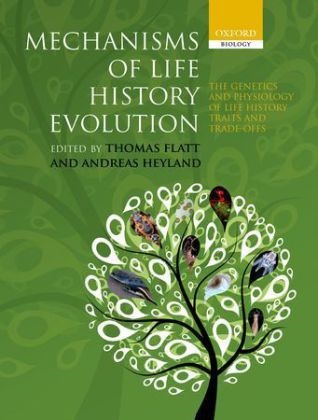Ulteriori informazioni
Zusatztext In this impressive and substantial edited work, Thomas Flatt and Andreas Heyland have gathered together contributions from numerous authors, many of them leaders in their fields, all aimed at a common goal: the integration of a mechanistic component into life-history theory. Although, as the editors state, this integration is still in its infancy, the volume they have assembled will help enormously in the growth of the infant concerned, which in turn will help in the further integration of evolutionary biology as a whole. Informationen zum Autor Thomas Flatt has been a Group Leader at the Institute of Population Genetics at University of Veterinary Medicine in Vienna since January 2009. His main research interest is in the biology of aging, life history evolution, and evolutionary physiology. He studied biology at the University of Basel, from where he received his M.Sc. in population biology in 1999, for work supervised by Prof. Stephen C. Stearns (Basel) and Prof. Richard Shine (Sydney). In 2004 he earned his Ph.D. in evolutionary biology from the University of Fribourg (under Prof. Tadeusz Kawecki). Between 2004 and 2008 he was a postdoctoral research fellow in Prof. Marc Tatar's laboratory at Brown University (Providence, USA), sponsored by the Swiss National Science Foundation and the Roche Research Foundation. He is a faculty member of the Vienna Graduate School of Population Genetics (Doktoratskolleg Populationsgenetik). He is also currently serving as a deciding editor for the Journal of Evolutionary Biology.Andreas Heyland is an Assistant Professor at the Department of Integrative Biology at the University of Guelph, Canada. He works primarily on the evolution and development of marine invertebrates. His interest in life history theory began as an undergraduate student in the laboratory of the late Paul I. Ward at the University of Zurich. After completing his MSc at the University of Zurich he continued as a Ph.D. student at the University of Florida in Gainesville, exploring the mechanisms underlying metamorphosis. After a post-doc in Neuroscience he started his faculty position at the University of Guelph in Ontario, Canada where he is an Assistant Professor in the Department of Integrative Biology. Klappentext This interdisciplinary volume unites evolutionary and molecular biologists from various fields (life history theory, molecular biology, developmental biology, aging, phenotypic plasticity, social behaviour, and endocrinology) who use studies of molecular mechanisms to solve fundamental questions in life history evolution in a variety of organisms. Zusammenfassung This interdisciplinary volume unites evolutionary and molecular biologists from various fields (life history theory, molecular biology, developmental biology, aging, phenotypic plasticity, social behaviour, and endocrinology) who use studies of molecular mechanisms to solve fundamental questions in life history evolution in a variety of organisms....
Sommario
- Foreword: Harvey's Legacy
- Preface
- Part 1: Integrating Mechanisms into Life History Evolution
- 1: Christian Braendle, Andreas Heyland, and Thomas Flatt: Integrating Mechanistic and Evolutionary Analysis of Life History Variation
- 2: Derek A. Roff: Genomic Insights into Life History Evolution
- Part 2: Growth, Development, and Maturation
- 3: Andreas Heyland, Adam M. Reitzel, and Sandie Degnan: Emerging Patterns in the Regulation and Evolution of Marine Invertebrate Settlement and Metamorphosis
- 4: Alexander W. Shingleton: Evolution and the Regulation of Growth and Body Size
- 5: Deniz F. Erezylimaz: The Genetic and Endocrine Basis for the Evolution of Metamorphosis in Insects
- 6: Richard G. Manzon: Thyroidal Regulation of Life History Transitions in Fish
- 7: Daniel Buchholz, Christine Moskalik, Saurabh Kulkarni, Amy Hollar, and Allison Ng: Hormone Regulation and the Evolution of Frog Metamorphic Diversity
- Part 3: Reproduction
- 8: Adam M. Reitzel, Derek Stefanik, and John R. Finnerty: Asexual Reproduction in Cnidaria: Comparative Developmental Processes and Candidate Mechanisms
- 9: Joshua A. Banta and Michael D. Purugganan: The Genetics and Evolution of Flowering Time Variation in Plants: Identifying Genes that Control a Key Life History Transition
- 10: Alan O. Bergland: Mechanisms of Nutrient Dependent Reproduction in Dipteran Insects
- 11: Dominic A. Edward and Tracey Chapman: Mechanisms Underlying Reproductive Trade-offs: Costs of Reproduction
- 12: Michael P. Muehlenbein and Mark V. Flinn: Patterns and Processes of Human Life History Evolution
- Part 4: Lifespan, Aging and Somatic Maintenance
- 13: Magdalena Hodkova and Marc Tatar: Parallels in Understanding the Endocrine Control of Lifespan with the Firebug Pyrrhocoris apterus and the Fruit Fly Drosophila melanogaster
- 14: Johannes H. Bauer and Stephen L. Helfand: Chapter 14: The Genetics of Dietary Modulation of Lifespan
- 15: Tonia S. Schwartz and Anne M. Bronikowski: Molecular Stress Pathways and the Evolution of Life Histories in Reptiles
- 16: Maris Kuningas and Rudi G.J. Westendorp: Mechanisms of Aging in Human Populations
- Part 5: Life History Plasticity
- 17: Benjamin G. Miner: Mechanisms Underlying Feeding-Structure Plasticity in Echinoderm Larvae
- 18: Paul S. Schmidt: Evolution and Mechanisms of Insect Reproductive Diapause, a Plastic and Pleiotropic Life History Syndrome
- 19: Paul M. Brakefield and Bas J. Zwaan: Seasonal Polyphenisms and Environmentally-Induced Plasticity in the Lepidoptera - the Coordinated Evolution of Many Traits on Multiple Levels
- 20: Brenda Rascón, Navdeep S. Mutti, Christina Tolfsen and Gro V. Amdam: Honey Bee Life history Plasticity - Development, Behavior, and Aging
- Part 6: Life History Integration and Trade-Offs
- 21: Aurora M. Nedelcu and Richard E. Michod: Molecular Mechanisms of Life History Trade-Offs and the Evolution of Multicellular Complexity in Volvocalean Green Algae
- 22: Birgit Gerisch and Adam Antebi: Molecular Basis
Relazione
[This book] single-handedly kept me off a computer for a long time and renewed my excitement about books. ... The content is motivating. Excellent chapters, sections and overview by the editors will turn this book into a much-read, dog-eared reference staple. Highly recommended. Andrew P. Beckerman, Times Higher Education

